CosMuseum Project: Memories and Souvenirs from planet Earth - Juniper publishers
Journal of Trends in Technical and Scientific Research
Abstract
The etymological origin of the word museum is muse. If the muse of our space era is the Cosmos itself, then a CosMuseum
is our proposition for a nomad museum in space, carrying
artworks-memories from Earth’s civilization. Remembering that every
additional gram of cargo in space expeditions is extremely expensive,
the lighter the cargo is, the more economical the expedition will be.
Conclusion: we cannot carry Pyramids and Parthenons to the CosMuseum.
Thus, this paper is proposing Michaloudis cultural cargos for this
imaginary museum in space; sculptures made of the lightest solid on
planet Earth together with a combination of digital images from Hence’s
artworks. The author’s first immaterial artworks are directly influenced
by Cycladic art. The co-author’s artworks are based on the traditional
medium of oil on canvas, which are based on earthly constructions of
termite mounds. In this paper we’ll present some of their artworks and
posit them as potential precursors for a cultural cargo from our
(h)Earth.
Keywords: Museum, Catastrophe, Silica aerogel, Periphery, Souvenir, Memory, Canvas, Termite mounds
Introduction
Dr. Ioannis Michaloudis is a forerunner in research
regarding the use of materials that bridge art and the new sciences of
space. The primary material currently dominating his research has been
developed by NASA, the nanomaterial silica aerogel into which he sculpts
his aer( )sculptures. Ian Hance is a PhD student at Charles
Darwin University under the supervision of the author. His works consist
of oil paintings on canvas based upon the subject of termite mounds,
native to the Northern Territory, which unknown tourists adorn with
found objects in various arrangements. The third co-author, Christine
Tarbett-Buckley is the Head of Collections at the Museum and Art Gallery
of the Northern Territory and a Research Fellow at Charles Darwin
University. She has a background in archaeology, art and law and
museology with research interests in the evolving concept of the museum
and the sustainability of museum collections into the future. Dr.
Katerina Koskina is an Art Historian-Museologist and in nowdays the
Director of the National Museum of Contemporary Art in Athens, Greece.
She was the curator of Michaloudis’ solo exhibition 11 aer( )sculptures
in the Cycladic Museum of Athens back in 2006. This paper interrogates
the practices/research of the two artists with the hypothesis that it
will be necessary at some time, in the not too distant future, to
situate a museum in space both as a repository of both original artworks
and as simulacra for works too large or weighty to be installed. We
maintain that the physical constraints will not allow for the
installation of art pieces or architecture that are typical to the
current museum arrangement. It is therefore our contention that replicas
and original art need to be rendered in weightless materials, digital
records, holograms, light projections and other media yet to be
discovered. The last sections discusses the natures and contexts of a CosMuseum
as seen by curators Christine Tarbett-Buckley and Katerina Koskina.
Thus this paper is a discussion of themes and contexts from two distinct
perspectives―that of practising artists and of museum professionals.
Michaloudis is a sculptor combining art with
technology by using the space era nanomaterial silica aerogel. It
constitutes of 99,9% air and 0,1% glass and has been extensively used by
NASA for the collection of stardust. When he was first introduced to
the material he was permitted its use only for the creation of small
size artworks. His concept of creating moulds of Cycladic figurines was a
result of the convention of their size. He suggests that these
primitive figurines function as a symbol representing the self, one that
is widely recognizable by the
public as such. This recognition enabled him to promote his
technique through utilising symbols familiar to the observer to
create an overarching theme. He called his work aer( )sculptures
as the only source is light in the absence of material. He chose
silica aerogel as a contrasting material with marble to create a
dialogue between the lightness of the aer( )sculpturess and the
weightiness of the marble figurines.
The incentive force of sculptural metamorphosis of the
Cycladic form may have plotted the chronological course from
the historically-loaded material of marble to the nowadays
space technology nanomaterial, suggesting a parallel journey
that started from the authentic form and finished as a “fake”
copy. To the artist, this journey could be summarized through
the creation of a pun on the Greek word plastos that has the
dual meaning of ‘sculpted/modeled’ and ‘fake’, with particular
reference to tourist souvenirs. The discussion of visual records
in digital photography speaks also about disappearance,
namely the original material that is left behind or perceiving
the original in an altered form, from a peripheral viewpoint.
Both artists and the one of the curators are situated in a unique
positioning of periphery being at the last frontier of Australia,
Darwin in the Northern Territory. Within this context, the
periphery functions as a stimulus to both produce art and to
secure its preservation. The dialectics of materiality/nonmateriality
of original to copy are examined through the
workings of ambiguous space, colour and form in the discussion
of Michaloudis’s sculptures and Hance’s oil paintings on canvas.
The materials discussed include the primary material of
silica aerogel in Michaloudis’s aer( ) sculptures and Hance’s
oils on canvas and the digital images he captures his subject
matter with. Then follows a discussion of the formal, nonformal
aspects of the imagery based upon Cycladic figurines
in their reference to Neolithic fertility idols and how both of
these references find their poetic connections as memories and
souvenirs. These memories and souvenirs from planet Earth
are to be placed in a hypothetical museum of the future named
here as CosMuseum.
Views from the Periphery
The view from space of Australia on the television screen is
so familiar and central whether that is on the weather channel
or the news channels yet its cultural positioning in the western
perspective has always been considered marginalised, (Figure
1). Historically it was one of the last continents to be mapped
by Europeans. To Australians, the last mass of Oceania was
always their centre and any effect of the perceived periphery
on their culture will not be discussed here. However, the
significance of memory in the oral tradition of Australia’s
Indigenous peoples will form part of the argument for inclusion
of souvenirs and memories in the museum, to offset the sole
reliance on digital data. Darwin’s remoteness in this largest
of all islands stands as a personification for the remoteness of
space or planet Earth’s remoteness within our solar system and
beyond. The experience of the materiality of visual cultures
from the “centre”, that is the rest of the world, has always been
Eurocentric.
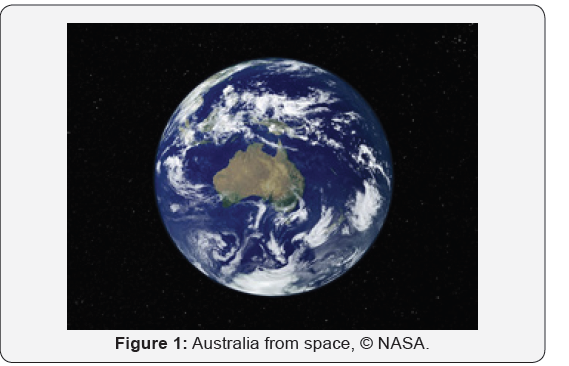
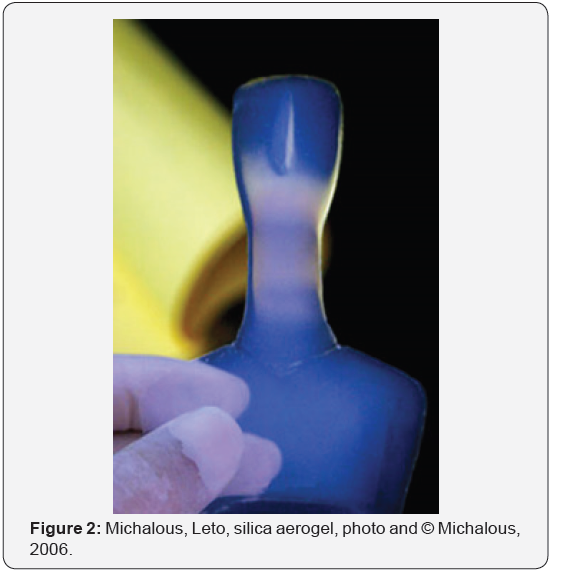
The Australian viewer’s experience of international
artworks has required leaving this island in order to see such
works physically. For the rest of the time this experience has
been substituted with the experience of the photographic
reproduction or online digital records [1]. It can be argued
that an artist in this context of the periphery is in an excellent
position to reflect on what are the possibilities beyond this
horizon; as being located on the periphery can provide a
clearer picture of the whole than can be experienced within
the confusion of the centre. The periphery can be a stimulus
to produce art. The periphery of Earth in the edge of space is
addressed within Michaloudis’s works while the subject matter
of termite mounds for Hance’s paintings are peripherally
located on remote areas of the highways of the tropical north of
Australia, (Figure 2&3). Hance’s costuming of these mounds is a humorous expression of tourist’s desire to see the nakedness
of these anthropomorphized mounds covered with clothing
and other materials. The concepts of distance and tourism
are discussed later in nostalgia, memories and souvenirs. Art
itself can be considered as a peripheral activity in that it has
a secondary or removed aspect from the primary source of
observation.

Another view of space that is clearer from the periphery is
the view of the night sky/space itself. Unlike most metropolises,
Darwin has relatively little night light pollution and even a
short drive out of Darwin produces excellent views of our
solar system and the Milky Way. The primordial contact that
humanity has with the cosmos here is visually much more
pronounced. The dialectics of natural light and artificial are
brought into sharp contrast by light pollution. The view of
space from major centres of the world is compromised by this
pollution. For this reason it is unsurprising that the telescopes
on Earth are situated in remote locations or placed in orbit
around the earth, again at the periphery.
Catastrophe: breaking materiality and remoulding immateriality
The initial colonialization of Australia can be considered as
a catastrophe for the culture of Indigenous Australians. There
have always been catastrophes for other cultures historically
with the disappearance civilizations and their artefacts, and
possibly with the merging of new cultures. The possibility of
cultural disappearance of any of the world’s societies is just
as concerning in the twenty-first century as at any time in the
past. It is with this threat in mind that the author’s proposal
of a nomad museum containing artworksmemories is a more
urgent consideration than an “ark” of artefacts. What these
artworksmemories will be made up of -or rather their imagined
possibilities- are discussed in the following.

The word terroir (from the French word for “earth”) evokes
memories of flavours/scent of the terrain. All the earthly
ecosystem factors that make up the characteristic of a product,
is terroir. In the author’s case, the cloudlike silica aerogel carries
the scent of earth’s sky as seen in Figure 2. In the co-author’s
case, the product is oil paintings of termite constructions
(mounds) made of earth in the Northern Territory (Figures
3&4). We see these residues or flavours as a kind of terroir, a
kind of subtle overtone or undertone rather like the complex
flavours in wine, forming a subtle metaphor for the “associative
radiances” or a memory of the earth itself. The catastrophic
breaking and scattering mentioned later as part of these
nostalgic memories speaks about the processes of creativity
itself: the other side of the coin of creating is destroying or
“breaking the mould”. In Michaloudis’s practice, the very solid
steel mould has to be “broken” to reveal the magical nonmateriality
of the silica aerogel sculpture. In Hance’s works the
visual breaking up of the space and formal 3D properties of the
termite mound /mould constructions into visual metaphors,
coupled with their abstraction into bidimentional painting is
the complement to the formative properties of Michaloudis’s
sculpture. The discussion of the dialectics of materiality/ nonmateriality
through these properties follows: in the author’s
case, the effects of light in a space/atmospheric medium of
silica aerogel and in the co-author’s the earth bound medium of
oil colour in its application to this abstract space and form will
be discussed below.
Dialectics of materiality
Silica aerogel consists of 1 per cent glass and 99
per cent
air, making it the lightest solid material on Earth [2]. The
scattering of light as seen in the Rayleigh effect is part of the
material properties of silica aerogel in which the source of light
changes the colour depending whether it is seen against dark or
light. In Michaloudis’s Leto (Figure 2) the ethereal blue quality
and its translucency contrasts against the suggested weight
of the Cycladic form when it is set against a black background.
The opposite complementary color that makes up the Rayleigh
scattering -gold yellow- is seen as a formal edge reflecting
against the formless black of space. The edge suggests skin or
surface; however, the skin or surface of the works is almost
invisible whilst the interior space of the works as coloured
volume or mass is poetically amplified. Similarly, the analogy
between the skin of the anthill construction with its clothing
and the skin of paint both conceal and reveal space as a volume
within Hance’s paintings (Figures 5-7).
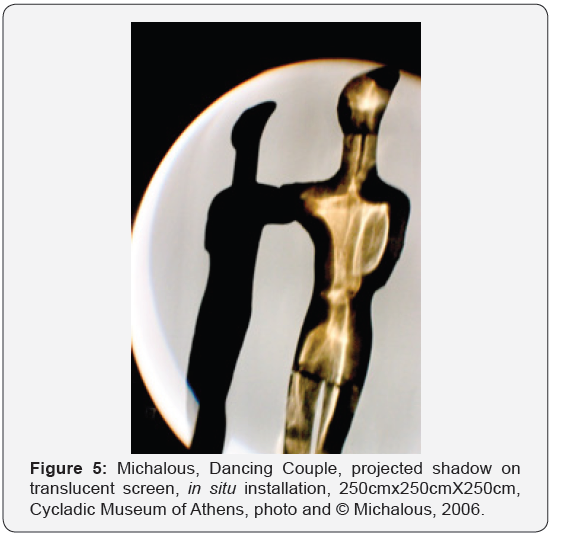
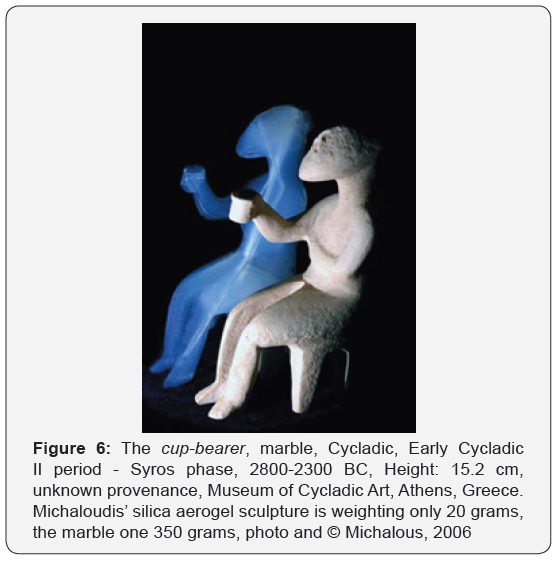

Thus, Michaloudis’s works are ambiguously both formal
and formless, similar to vapour or smoke. When these works
are set against the black void, their conflicting qualities speak
of the spiritual and the dialectic of material/mystical. These
properties stress the function and the binary opposites of
colour as complementary and function as an expression of
the spiritual, abstract and perhaps mysteries of the cosmos
via their ambiguities of space and hue. In Michaloudis’ works,
many of the sculptures and artworks represent symbolically
an anthropomorphised female figure in some of the Neolithic
Cycladic figurines. This symbol can also be located in Hance
works through the termite mound functioning as a “Mother”
form. Within this reference we can locate other fertility idols
such as the Venus of Willandorf. Michaloudis notes that his
Cycladic figurines similarly reference a symbol for the self
which is widely recognisable and resonate with the public.
That there are references to James Lovelock’s hypothesis of
Gaia, or, put in a more poetic way, Mother Earth, in addition to
this original symbol of the fertility goddess. The Mother Earth
reference adds poignancy to the sculpted and dematerialised
images that could be placed in the CosMuseum. In Hance’s case
the representation of these anthropomorphised figures of the
termite mounds is the counterpoint to the ethereal qualities of
the silica aerogel sculptures mentioned previously.
In Michaloudis’ work the cup-bearer, (Figure 6) the
dialectics of the weight of solid marble and the ethereal light
qualities of the silica aerogel provoke feelings of ambiguity
in its relationship to the density of the souvenir as an object
embodying a sense of memory (and terroir). Both objects are
seen in Figure 3 set against void or black space, which itself
holds both formal and informal connotations in its reference
to the concepts of the formlessness and its mutability [3]. In
Michaloudis’ artworks the figures/constructions are nearly
always seen against these black rectangles ovals and squares
which actively reference either the cosmos in a formal way or the void in its connotations of disappearance. Form
functioning against the void and the suggested “memory” of
an original form plays with the ideas of plastos in this work―
“fake” as in a souvenir taken from the original archaic marble
Cycladic sculptures. These are copied into tourist market
copies as souvenirs for sale. From these copies Michaloudis
makes a mould (memory) in which the silica aerogel is cast.
The point being here that material souvenirs are very different
from memories, and the authors hypothesis asks whether the
artists operating on the periphery are in a more advantageous
position to consider the “collection” of the whole; say of digital
memories and works of art in space age materials, not just
souvenirs in their materiality Two works reference the duality
of the past in the present and extend possibilities for their entire
representation within a future museum. The Dancing Couple in
Figure 4 and Figure 5, through its use of space age material
recreates an original form as a duplicate of a missing/lost
“idol” which produces a shadowed reflection as an immaterial
duplicate. These artwork regenerate the past through their
inclusion of lost elements of cultural icons. Their resemblances
in the present converge as an idealised representation for the
future.
Memory in Future Time
The materiality of memory in Michaloudis’ works are
discussed in the following catalogue‘s text by the curator
Katerina Koskina for his solo exhibition 11 aer( )sculpturess in
the Cycladic Museum of Athens, back in October 2006. “Ioannis
Michalou(di)s is one of those contemporary artists who though
espousing international visual inquiry and language, and
indeed is involved with their most recent experimental and
scientific applications, remains at the level of idea and of form
a supporter of local culture. Thus, from his interdisciplinary
experience and training in both art and science, works have
emerged that literally hover between the past and the future.
This is due in large part to the material to which he was first
exposed in a research at MIT and immediately began using
silica aerogel., But Michalou(di)s, as he prefers to sign his
surname, by contracting it, as he does also with the title of
his recent works - voluntarily trapped in a game of knowledge
and chance, of etymology and joke, was fascinated by this
particular material, which looks like solidified air and is
widely used by NASA because of its insulating qualities. Silica
aerogel, although ubiquitous in space and high technology, is an
unknown material and a scientific paradox for artistic creation,
despite its truly magical image and texture, which allows it
to “transform”: the painted skies of the Venetian School into
virtual reality. And yet its basic constituent, silica, for all its
fragility, is a material of high durability to time, a material with
continuity and memory. Perhaps this particular characteristic
of it makes it most suitable for serving a diachronic value such
as art.
In an age when everything aims at dematerialisation,
this material composed of 99% air and 1% glass follows the
opposite course. In essence it “materialises” “nothing” and it
owes its plasticity not to its principal ingredient, air, but to that
minimal percentage of glass, which gives it “body”. That is why
Michalou(di)s has called his works aer( )sculpturess, revealing
both their constitution and the sidereal origin of his material.
A material that exists pre-eternally in the universe in the
form of particles, but whose present form is so recent that it is
considered a material of the future.
However, what is more interesting for the viewer of the
works is not the composition or the provenance of the material,
for all the admittedly alluring image it offers, but the way
in which the artist incorporates it in the creative process.
Michalou(di)s uses the astral material to represent Cycladic
figurines, that is works of the 3rd millennium B.C. This is not
the first time that he feels that the ancient form demands from
him a metamorphosis. The archetypal form of the Cycladic
figurines, which is the cultural nucleus not just of Greece but
if the whole of the West, appears because of its abstraction
eminently timely and suitable for “habitation” by a supermodern
material. Michalou(di)s apparently conceived this
message of the timelessness and modelling of form, which
inhabits the collective subconscious, when he decided to
predict the future image of the figurines by “embracing” them
with the nostalgia distinctive only of a Greek who has lived
abroad for many years.”
Chaos as background
In both the black ground of the sculptures and paintings,
(black being an amalgamation of all colours of the spectrum
in an additive way) Michaloudis’ sculptures also experiment
with the disappearance of colour and light. In Michaloudis’
sculptures the disappearance or flux perhaps between the
polarities of light contained in the aerogel produces the
complementary colours of blue and a golden orange (depending
on which view is taken of the work). This mutability or
shifting of view is an expression of the spiritual values in
our contemplation of the cosmos, or at least the importance
of a shifting perspective underpinned by the dialectics of
materiality/non-materiality. The description of Michaloudis’
aer( )sculpturess as being the only source of light in the absence
of material or a non-materiality of the aerogel forms a poetic
expression of both the spiritual form or memory. The painted
black backgrounds of Hance’s work similarly reference both
void and formal space at the same time. They also reference
the in-between space of the canvas itself covered by pigment,
the sensed space of advancing forms surfacing in the picture
plane. Rather than receding back into the picture plane as in
Renaissance perspective, the volumes established sit forward
in ambiguous space, (Figure 7). Glossy transparent backs and
solid black pigments combined with their relative “silvers”
explore this in-between space. Other artists such as Gerhardt
Richter and Rembrandt have used the ambiguities of black.
Rembrandt’s tensions of warm and cool blacks similarly give life
and articulation to an otherwise void of black. Pierre Soulages similarly used impasto glossy blacks against flat blacks to
explore formal and spatial properties. The void also speaks
about disappearance and if we accept Baudrillard’s concepts of
reality in our age (the Anthropocene) as disappearing behind
the black screen of the Internet and digital media, there is
poignancy inherent in the black screen or black rectangle of
painting in the sense of loss or absence [4]. Black also speaks
about the invisible and as such invokes the non- material or
spiritual. On the other hand, a texture and impasto surface in
black paint draw attention back to the surface and thus speaks
about the weight or gravity of the artwork. The black circle in
Michaloudis’s gold Cycladic figurines holds expression of the
chaos of the void whilst simultaneously creating a tangible
space established by the perspectival positioning of the two
Cycladic figures (Figure 8).
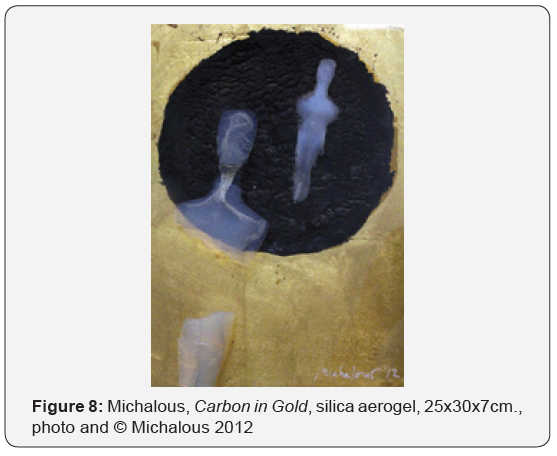
The weighty solid panel made of scorched wood in Figure
8 is covered in gold leaf accentuates the weightlessness and
suggested movement of the silica aerogel figures. Gold in
itself sits ambiguously between form and light in its reflective
properties and its physical metallic property. Conceptually
it references the spiritual in its associations with cultural
symbolism of the divine. Not so in Hance’s work Night Piece
(Figure 9), in which materiality references the purely secular
in its references of the earthly grotesque soil presented a
basic human female form. The dressed up figure is set within
the space of the periphery of a township against a warm
black that functions as both atmosphere and solid humidity.
This black is suggested by a solid impasto paint surface and
includes visible fluid runs of paint. Again black is used in its
ambiguities of weight and weightlessness. The singular f igure
evokes a feeling of solitude and isolation that also expresses
the periphery. A connection to ancient images such as the
Wandjina (Figure 10), which is executed in a similar medium,
that of earth/red ochre, reinforces concepts of earth bound
materials. However, these Wandjina are representations of
spirit beings grounded in earth’s palette; a counterpoint to the
spiritual blue of Michaloudis’s Cycladic figurines. The Wandjina
figures are earth bound in more ways than one; being painted
on a rock shelter -like the pyramids and the Parthenon- they
can never be transported to a space museum.
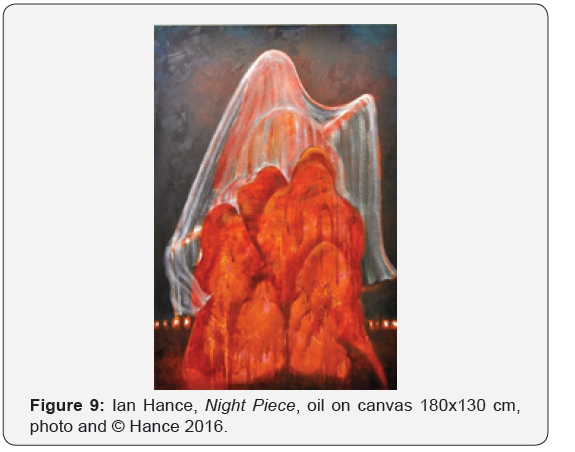
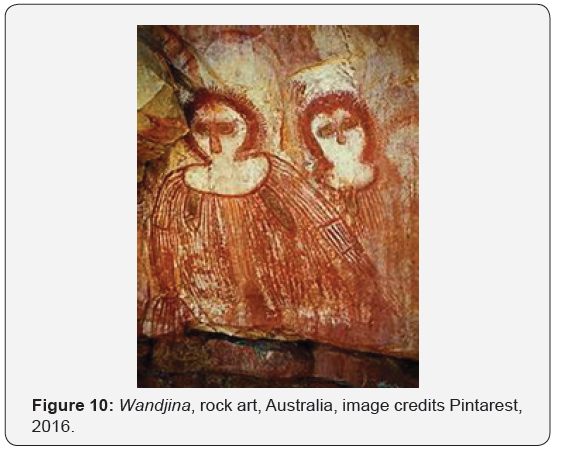
Further to the dialectics of materiality/non materiality, the
idea of translating the digital images of the works into light
images for a repository, a CosMuseum in space is proposed in
order to hold memories of earthly constructions as art. In this
process of the copy of a copy-or simulacra-the memories of
earth and paintings produce nostalgia and an ironic reflection
of what is left behind. Analogous are the processes of the
mounds themselves as aspiring to become space themselves,
both internally and externally. The reproduction of original
works based upon the digital recording (a copy) are then
copied by a digital photograph (a copy) to be reinvented into
the digital trace that finally appears on the screen in the form
of RGB light that constitutes pure digital data. Through these
methods we enter the arena of the aesthetics of disappearance,
which reside in memory, nostalgia and our imaginations.
Novalis’s quote “philosophy is really a nostalgic desire
to be at home” points to a fundamental truth about memory
being bound up in nostalgia that is also beautifully alluded to
in another quote from Proust’s Swann’s Way; “When nothing
else subsists from the past, after the people are dead, after the
things are broken and scattered… the smell and taste of things
remain poised a long time, like souls…bearing resiliently tiny
and almost impalpable drops of their essence, the immense
edifice of memory”. Thus the question arises; how can a
museum in space help to create a sense of belonging contained
within our memories? As with any movement of humanity into
newly colonised land (or space) there is traumatic disjuncture
with a new environment. Historically when any civilisation
repositions in new territory, it carries a raft of problems, not
least is the equating of this new territory as home. As Stephen
Muecke puts it, “…existence of course is precarious, but never
more so than when it is conceived as being without attachment
or belonging” [5].
The current world crises in refugee movement and
migration have brought this problem into sharp focus. The
authors propose that similar to the movement of migration
people need to carry their culture with them and therefore
cultural cargoes must be made manageable in order for
space needs to be addressed. Thus another question arises;
is it through dualities and ambiguities that some of these
issues can be viewed via shifting perspectives? As discussed
above, Michaloudis’s and Hance’s research and resultant
works contain dualities of meanings and overlays of cultural
signifiers. Both artists use the ideas of tourist souvenirs kept
and things or traces left behind as their primary subject matter.
These processes point to new ways of registering memory as
traces, taste or scents and in non-written way as in the initial
description of terroir and nostalgia.
The mention of the non-written invokes association
to memories, which are embodied in the oral traditions of
Indigenous peoples. Indigenous culture binds the visual
image to the important stories and natural sciences. The
absence of the written word within these cultures allow a
special profundity that is never forgotten simply because it
must always be retained as memory. The image of the rock
painting of Wandjina in the Kimberley is an excellent example
of knowledge and cultural memory bound into a single image
the image itself being the primary language, which contains
the spiritual values of the Dreamtime interwoven with the
physical aspect of the earth-bound timing of the arrival of
the wet season [6]. The increase in humidity make its earth
colours much more vivid at this period making the image
“live”. These images are “sets of symbols used to communicate
meanings developed into a symbolic universe, in which art,
language, myth and religion (are) were interwoven …” [6]. The
implication is that the more we rely solely on recorded data,
the more our memories atrophy. It is hoped that any museum
of the future could include similar artistic memories as well
as other records/ artefacts of natural history, science and
cultural cargoes from earth.
The Museum of the Future
The Museum of the Future
Is it perhaps then that through the eyes of artists who
proposes the selection of what constitutes the museum of the
future in its relation to the cultural memories of earth are to be
addressed. In the past, such artists have considered a museum
of the future as André Malreaux in 1967, who proposed in
his “museum without walls” that photographic records of
all important cultural artefacts be placed in a space as an
economic and weightless record [7]. Similarly, it is proposed
that a museum of the future would utilize new processes that
apply or have been developed out of space age technologies that
are also weightless and economic in size. An excellent example
of an artist creating work from new material is embodied
Michaloudis’s sculptures made from the space material silica
aerogel, reiterate that the artist’s muse is the cosmos itself,
coupled with the space technology that produced the silica
aerogel [8]. Souvenirs and “souveniring” has always been the
tangible evidence of tourism and the leaving behind of evidence
or tourist memento states that “I was (t)here”. The other notion
that seems to drive such activities is the need to turn the
“nowhere” of a remote place or space into “somewhere” [9].
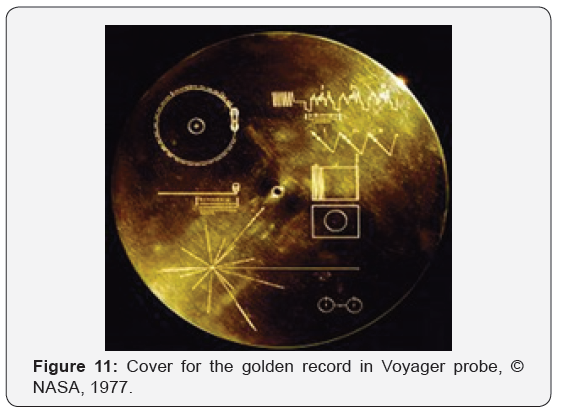
The golden disc sent out into the cosmos on Voyager in 1977
of course sends out a different message that of we are /were
here (Figure 11). The “were here” holds a particular poignancy
of the nostalgic. The point being here that material souvenirs
are very different from memories, and the author’s hypothesis
asks whether the artists working in the peripheral are in a
suitable position to think about a “collection” of the whole; say
of digital memories and works of art in space age materials,
not only souvenirs in their materiality (Figure 12). So, it is in
the digital copy of digital copy of an analogue copy (or material
copy) together with three –dimensional works are made from
aerogel and/or other media creates the constraints for a new
visual environment. Weightless media is in itself a type of
memory or souvenir that we propose to be a light and colour
soaked “apparition” constituting the artwork left behind or disappearing from Earth. The poetic interpretations of space
fused into the working of materiality as a concept within the
various mediums discussed here in the works of Michaloudis
and Hance point to a new way of representing works of art
as memory, and a different perspective on the possibilities of
storing cultural cargoes.

These possibilities of storage extend outside their function
as merely souvenirs from Earth to suggest their ability to
also manifest as profound memories. As these materials and
copies are the lightest and most spatially economic mediums
known to date, they are eminently suitable to be housed in a
CosMuseum the museum of the future. CosMuseum is imagined
as a virtual and universal museum. Its collection is created
as a data bank sculpted from an aggregate of museum digital
data, developed in a unified structure by the global museum
community and enabled through virtual transmission into the
cosmos. CosMuseum opens up the possibility of a narrative
environment that is representative of our collective humanity,
unbounded by temporality, and made accessible to an audience
both known and unknown. It is destined to provide a space
symbolic of our times, one that acknowledges the incognisant
of the present. Simultaneously the museum posits a vision
towards a timeless future, in which visitors in space may
process visual and sensory cues in ways we cannot control,
imagine or predict. CosMuseum is envisaged to contain the
memory of our present, almost as simulacra of Earth’s cultural
and environmental history, for a future time of enduring
uncertainty.
Two ventures pioneer the messaging in space of our
civilisation and are precursors to concepts broadened in the
CosMuseum: The nomadic Voyager probe launched in 1977
included sound and image captures in CD prototype that Jimmy
Carter, then President of America, introduced as: “This is a
present from a small, distant world, a token of our sounds, our
science, our images, our music, our thoughts and our feelings.
We are attempting to survive our time so we may live into yours”
[10]. And the Moon Arts Project, scheduled for launch in 2016.
It delivers a technically advanced four chambered time capsule
to the Moon establishing a permanent ‘cultural heritage site’,
containing a discrete selection of items representative of all
Arts and Humanities with considered ‘potential to last many
millions if not billions of years’ [11] (Figure 13). Significantly,
two artworks of the author, Bottled Nymph and Noli Me Tangere
are selected to be included to this project that provide an
intersect between the present and the future through their use
of an evolved medium, one that has origins in space science itself
(Figures 14&15). Their “otherworldly’ qualities, both ethereal
and cosmic, combine to empower them as objects which speak
of an endless ‘generative process of making meaning, making
story, and understanding time’ [12].
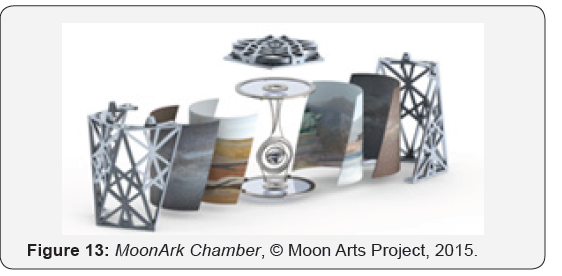
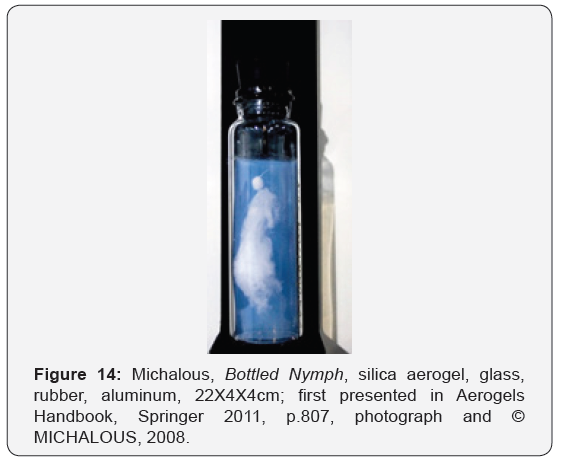
CosMuseum expands on both space incursions through
development of a museographic approach that pursues an
encyclopaedic rather than selective compiling of cultural
data. This approach transgresses discourse between art
forms, cultures, politics and geographic regions to present a
pluralistic expression in virtual format of our humanity and
collective history. The basis for a cultural databank as required
for the collection of CosMuseum can be advanced through the
development of a number of cultural collection aggregators.
Known and operable examples include: ‘Trove [13], Digital
Public Library of America [14] and Europeana [15,16]. Each of
these platforms provides digital access to collective cultural
resources that cumulatively amount to almost 600 million
items. A formal ontology prepared by the International Council
of Museums (ICOM) through its International Committee for
Documentation (CIDOC) provides a conceptual framework for
integration of cultural data between disparate and diverse holdings [17]. Inclusive development of global content will
take many decades to achieve. Consistent data standards,
collaboratively applied in a sovereign approach across a global
museum sector would provide an apparatus for expansion
and centralised development of a globalised digital cultural
heritage hub from which CosMuseum would continue to build
and to draw its content for future transmission. While digital
access as a process is a dissociation from the material in
form and presence, the proliferation and mass of digitisation
projects have already altered the cultural landscape in which
museum collections are accessed across shared platforms.

This changing access enables multiple associations
and interpretations to generate. CosMuseum redefines the
authentic to include its digital derivative and in doing so,
enables on-going authorship of meaning and encapsulation of
memory by association. Collections vulnerable to catastrophe,
degeneration, decay, neglect or disinterest prevail through
preservation albeit in altered or immaterial digital form/s. The
concept is challenging to our traditional view of a museum as
a repository filled with objects maintained in original form
and functioning as true and authentic expressions of our
earthbound civilisation which are illuminated in a vocabulary
structured by the ideological constraints of our time. Embedded
meanings associated with concepts, memories, traditions,
ritual, spirituality and technical or artistic achievements are
subliminal as the resemblance or presence of an object in
CosMuseum bears its own significance. Material composition
becomes secondary to its being in CosMuseum through the act
of placement and transmission.
In juxtaposition to mineral compositions that have
long preserved the evidence of our human settlement, the
immaterial in virtual or newly envisaged formats becomes
the evolved embalming tinctures in which the evidence of
our civilization can be cradled. CosMuseum proposes that
it is possible for reality to be realised at any one moment in
time. The artist Grayson Perry expressed a similar sentiment
in regard to uncontrived narratives during his exhibition of
works at the British Museum in 2011: “That I am an artist and
not a historian and this is an art exhibition does not mean it is
any less real. Reality can be new as well as old, poetic as well
as factual and funny as well as grim” [18]. Through aesthetic
forms, in a sensory language, the CosMuseum provides a
platform to experience and to remember. Development of
CosMuseum is precipitated by an alliance between the museum
sector and space science to innovate the project and realise
technology that creates a future sustained within the universe,
in which evidence of our collective humanity poses an enduring
imprint. In visualizing CosMuseum examples of virtual and
interactive enclosures developed by Kenderdine and team can
be seen which enable access to cultural landscapes and museum
collections in previously unimagined detail and resolution [19].
CosMuseum creates a virtual landscape through both its digital
architecture and through its adaptive use of trans-disciplinary
digital technology that holds the potential to recreate the now
in the future. CosMuseum c ould b e l ocated e ither i n a f ixed
position or as a nomadic object traversing the cosmos, subject
to technical challenges in space technology and its ability to
facilitate the selected global collective resources including:
data transmission, data access and operability in a timeless
and sustainable projection. As weight and weighted matter
is a discerning feature to what could feasibly be included to
a museum in the cosmos, emergence of new media explores
the possibility of conversion not just in digital formats but
also in weightless space materials such as aerogel adapted by
Michaloudis in creation of his works. Any increase in range
of payload available to space travel could include original or
replicated forms to CosMuseum that would no doubt enhance
humankind’s physical presence within the Cosmos.
In concept, the CosMuseum holds a belief in the ‘numinous’
[12] experience posed through interaction with museum
objects that metaphorically transport observers beyond the
self as new meanings and narratives are contemplated over
time and space, perhaps without possibility of being anchored
to the reference to the now. Objects in the CosMuseum are as
pilgrims on a journey that bear witness to our existence and
evolution. In this way, there are similarities to object-centred
museums purposed to make ’sense of our world by discovering
and interpreting the past and present for the future’ [20].
Aestheticism- as the principal agent- is designed to transmit a
sensory expression that in examples of works by Michaloudis
and Hance have their origins in the periphery, in prehistory, and
from a region once perceived as terra nullius that paradoxically
holds evidence of the longest continuous human settlement on
this planet [21-23]. A fitting inclusion to a cultural package on
a journey as yet not fully realized [24,25].
Conclusion
The CosMuseum project is a realisation of our earthly frailty
and undeterminable future. It proposes a migratory pathway
through which the evidence of our civilisation can journey.
Works by both artists are embedded with symbolism and meaning and provide example of the profundity concealed and
expressed in material and immaterial forms that transgress
time. The tension created through conceptualisation of cultural
loss is abated through possibility of preservation and sanctity
found within carriage of CosMuseum. Concepts of preservation
are shown to be achievable through projects like MoonArts
and other digital technologies in which museum collections
are accessed and interpreted. New weightless materials such
as silica aerogel allow new original works to be included in
the CosMuseum as well as forming simulacra that encapsulate
memories of other earthbound art works. It has been shown
that these cultural cargoes embedded in a new Aestheticism of
the Digital are true and authentic works-memories as well as
being souvenirs from planet Earth.
To Know More About Trends in Technical and ScientificResearch click on: https://juniperpublishers.com/ttsr/index.php
To Know More About Open Access Journals Please click on:




Comments
Post a Comment